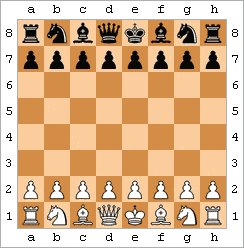
- Chess World Cup
- FIDE Grand Prix
- Olympiad
- World Championship
- List of strong tournaments
- List of world championships

- Checkmate patterns
- Chess openings
- Chess strategy
- Chess tactics
- Chess theory
- Endgames
- Pawn structure
- Problems/Compositions












|
 Animation demonstrating Scholar's Mate
Animation demonstrating Scholar's Mate |
||||||||||||||||||||||||||||||||||||||||||||
In chess, Scholar's Mate is the checkmate achieved by the moves:
The moves might be played in a different order or in slight variation, but the basic idea is the same: the queen and bishop combine in a simple mating attack on f7 (or f2 if Black is performing the mate).
Scholar's Mate is sometimes referred to as the "Four-Move Checkmate", although there are other ways to checkmate in four moves.
|
|
|||||||||||||||||||||||||||||||||||||||||||||||||||||||||||||||||||||||||||||||||||||||||
Unlike Fool's Mate, which rarely occurs at any level, games ending in Scholar's Mate are quite common among beginners. After 1. e4 e5 2. Qh5 Nc6 3. Bc4, if Black continues 3... Nf6?? then White can end the game immediately with 4. Qxf7#. However, Black can easily avoid the mate: either 3...Qe7 or 3...g6 defend against the threat. If White renews the Qxf7 threat after 3... g6 4. Qf3, Black can easily defend by 4... Nf6 (see diagram), and develop the f8-bishop later via fianchetto (...Bg7).
White might also try this sequence of moves, starting from the Bishop's Opening: 1. e4 e5 2. Bc4 Bc5 3. Qh5 (threatening Scholar's Mate on f7) and now 3... Qe7! (see diagram; 3...g6? instead would be a big mistake, allowing 4.Qxe5+ and 5.Qxh8) and Black is not only safe, but will attack the white queen later with ...Nf6. Alternatively, Black could have stopped White's plans early on by playing 2...Nf6 instead of 2...Bc5.
Although a quick mate on f7 is almost never seen in play above beginner level, the basic idea underlying it - that the f7-square, defended only by Black's king, is weak and therefore a good target for early attack - is the motivating principle behind a number of chess openings. For example, after 1. e4 e5 2. Nf3 Nc6 3. Bc4 Nf6 (the Two Knights Defense), White's most popular continuation is 4. Ng5 attacking f7, which is awkward for Black to defend. The Fried Liver Attack even involves a sacrifice of the knight on f7.
The Wayward Queen Attack (1. e4 e5 2. Qh5?!) and Napoleon Opening (1. e4 e5 2. Qf3?!) are both aimed at threatening Scholar's Mate on the next move (3. Bc4). Although the Napoleon Opening is never seen in high-level competition, the Wayward Queen Attack has occasionally been tried in tournaments by Grandmaster Hikaru Nakamura to achieve a practical middlegame for White.
Scholar's Mate has also occasionally been given other names in English, such as Schoolboy's Mate--- which may be seen as better reflecting in modern English the sense of 'novice' which was the word Scholar's original connotation--- and Blitzkrieg (German for "lightning war", meaning a very short and quick engagement) (Kidder 1960).